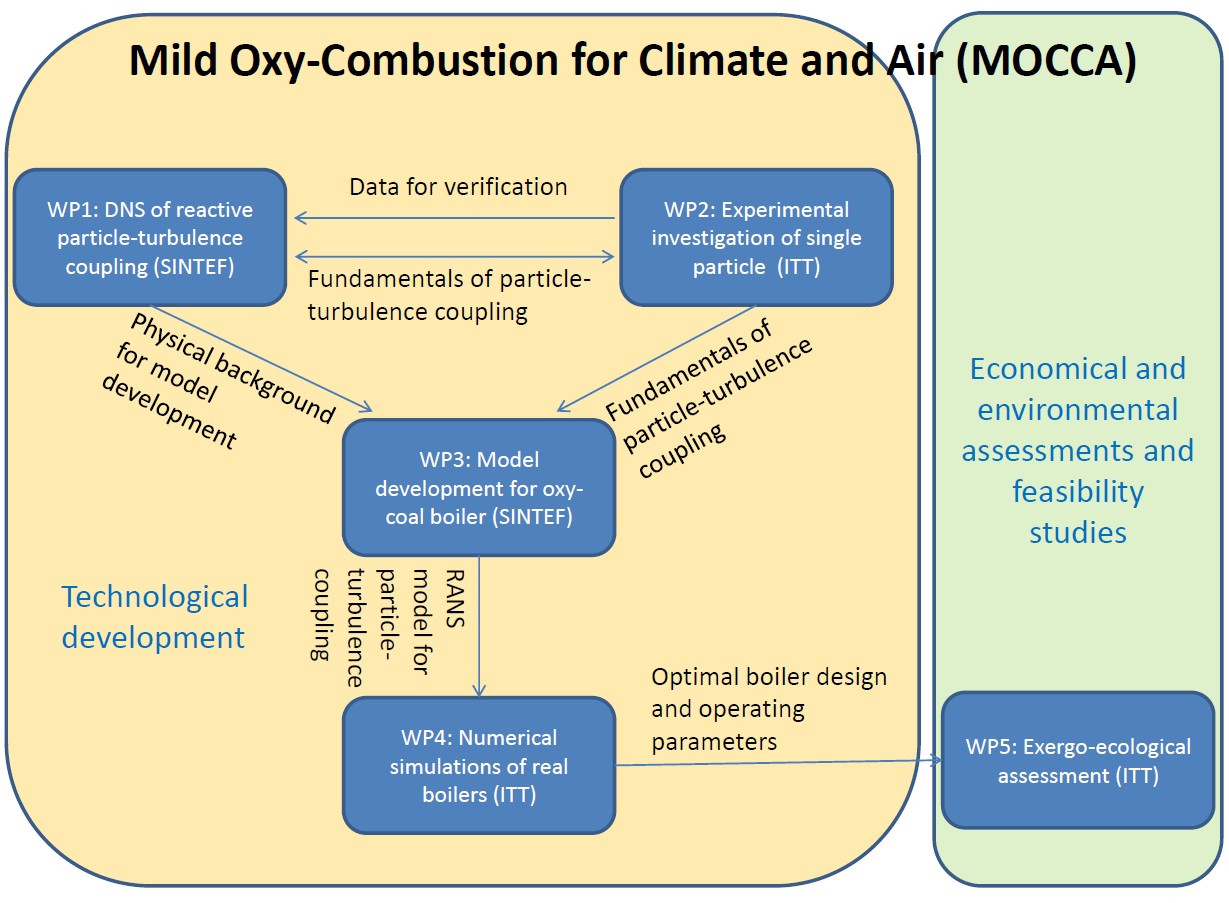The project will be organized in five work packages (WP's). The logical structure of the project is presented in the Figure below.
WP1:In this study, a turbulent mixture consisting of Oxygen and Carbon dioxide at high temperature will be seeded with reactive particles. The turbulence in the mixture is either forced or decaying isotropic turbulence. The burnout of the particles will be studied with an emphasis on heat and mass transfer between the fluid and the particles. The reason for doing this is that a good study of the reactive particle-turbulence coupling has never been performed. Combining the outcome of this DNS study with theoretical models for reactive particle-turbulence coupling will
allow us to significantly improve CFD models for the reactive particle-turbulence coupling. Having accurate models for reactive particle-turbulence coupling is crucial for a good CFD simulation of MILD combustion, and as such, it is a pre-requisite for obtaining reliable simulations of full boilers and burners.
If time permits, a DNS study of a section of a superheater tube bundle will be conducted with the focus on conditions relevant for MILD oxyfuel combustion of coal (or biomass). This study will be based on the methods used in previous work by members of the group on particle impaction on single [5] and multiple tubes [6]. In
addition to what has been done in previous studies we will now also investigate the effects of thermophoresis, brownian motions and turbulence in the incoming flow.
Simultaneously, at the ITT the existing test stand will be rebuild for pulverized coal combustion investigation. Coal particles will be supplied to the stream of hot gases simulating different atmospheres which may be present in an oxy-combustion boiler. Particle trajectories will be traced using PIV technique. There it also attemption will done to measure the temperature of the particle surface.
During this phase intensive bidirectional knowledge exchange is required in order to obtain a validated model of turbulent single particle combustion, which will be the main outcome of WP1 and WP2.
The aim of WP3 will be to use the knowledge gained in WP1 to produce a RANS sub model for the coupling of reactive particles and turbulence. This will be a model which is parallel to say the k-epsilon or RSM models for turbulence modeling and EDC or EDM for turbulent combustion modeling. This work will be done in close
collaboration between the two partners since it is important for SINTEF to know the exact interface with the model used by Silesian. When finalized this model will be implemented into the RANS code which ITT will use for the combustion chamber simulations in WP4.
Modeling of a real boiler with MILD oxy-combustion will be peformed at ITT. In the first period, standard models of combustion will be used (because newly developed will not be yet ready) to select the best geometry of the boiler and the best configuration of oxygen and fuel nozzles . When the RANS model developed in WP3 becomes available, it will substitute the standard model. Finally a series of tests will be perform to test fuel flexibility, applicability to small scale, the possibility of improving the purity of flue gases and the possibility of reducing the size of boiler. This will be one of the most important packages, summarizing the achievements of the previous
ones.
Development of new energy technology require evaluation of resource management as well as environmental aspects. Thermodynamics offers two modern techniques in this area. The first one is the thermo-economics which is used to investigate the internal efficiency of resource management. The second is thermo-ecology which is used to investigate the influence of the system on the depletion of non-renewable resources. Both methods will be applied for the assessment of the proposed system from the ecological point of view.

